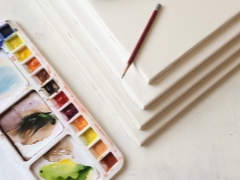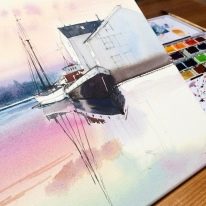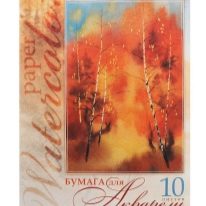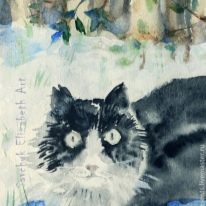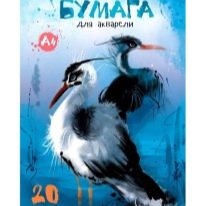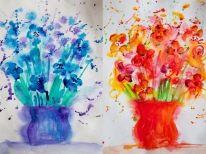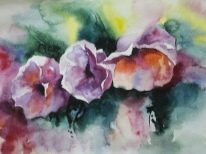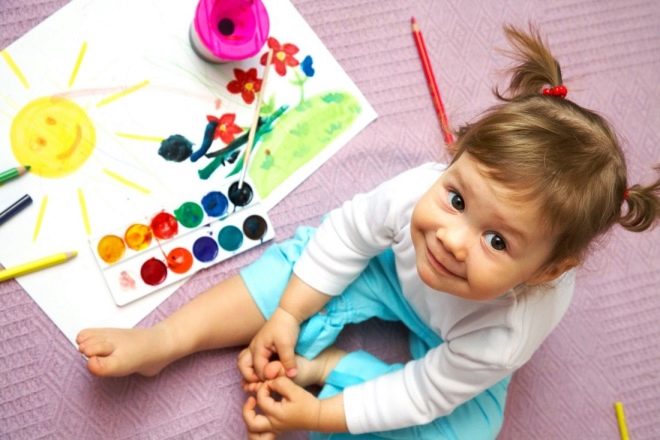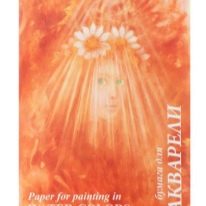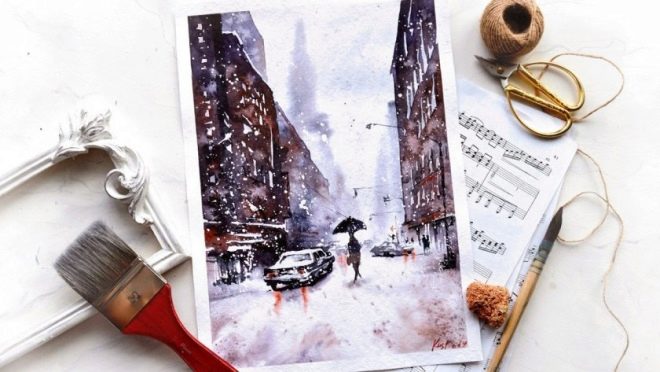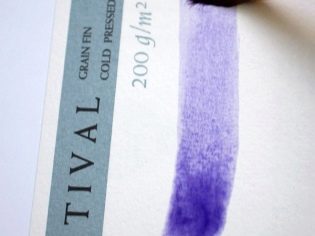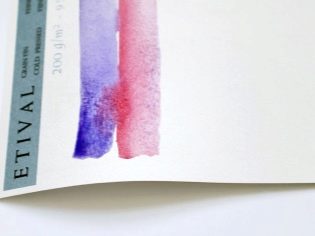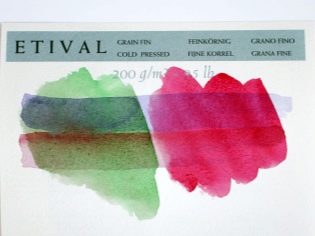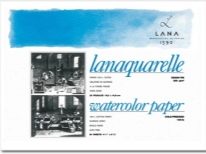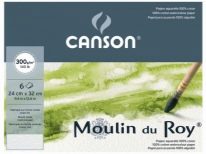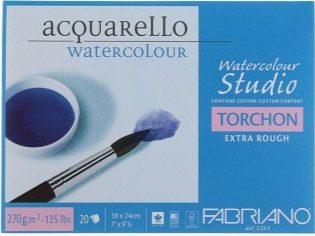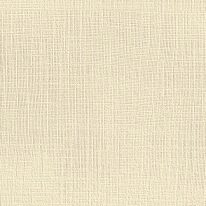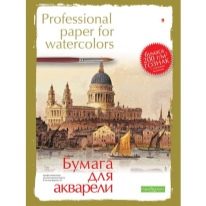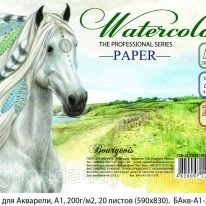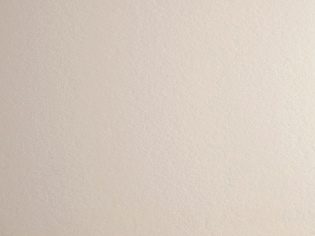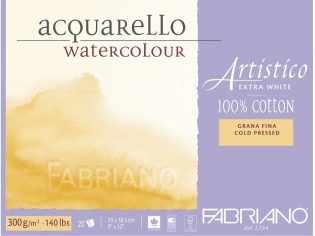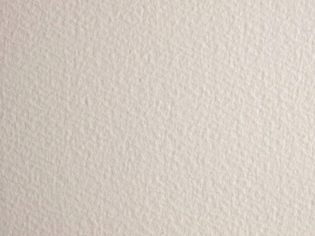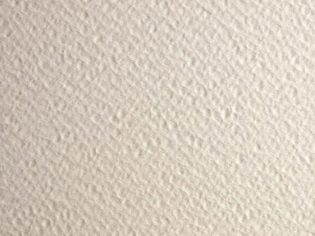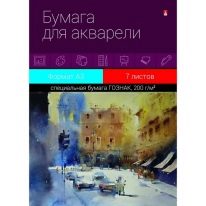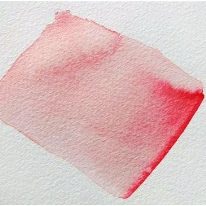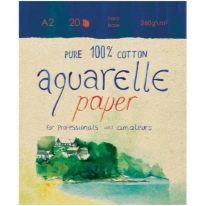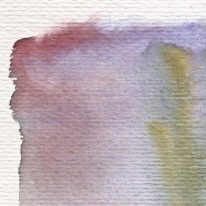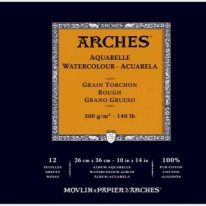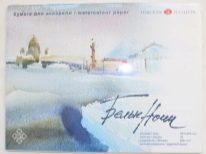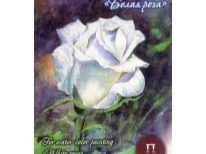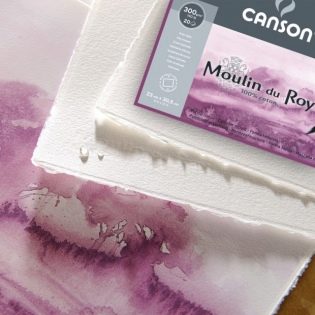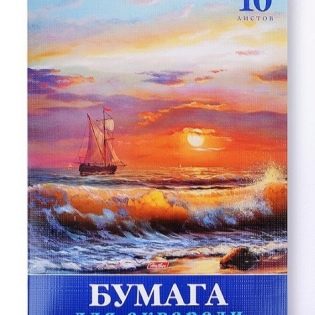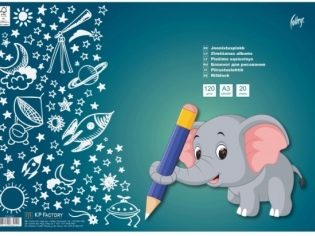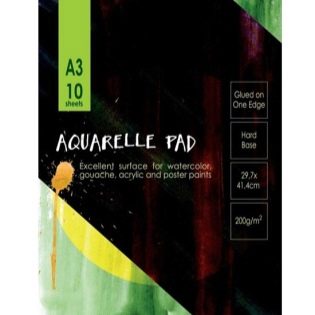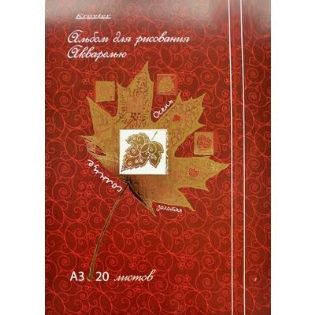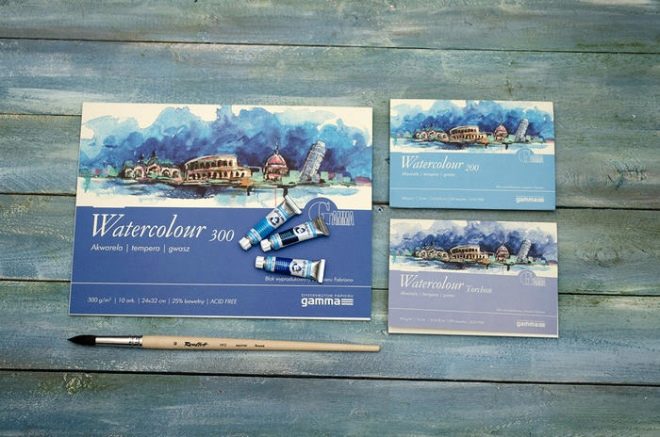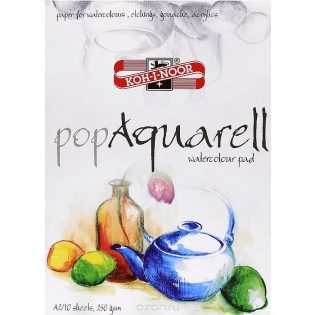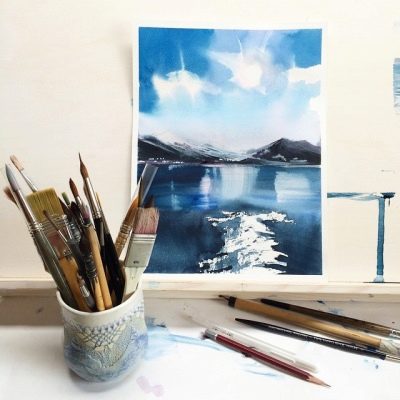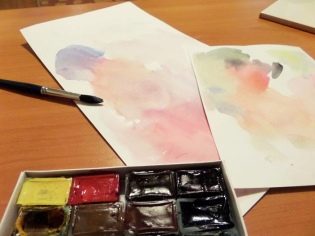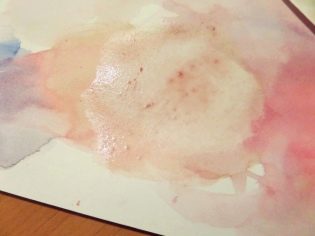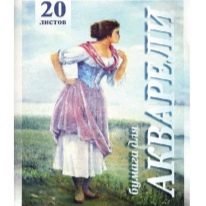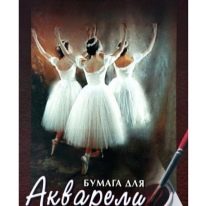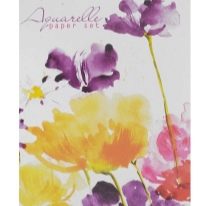Paper for watercolor: the best options
For young children who are just learning to draw, parents usually get the simplest drawing supplies, but any artist will confirm that even small details are important for full mastery of art. Literally everything matters, not excluding the base, that is, paper. The reason for the child's average marks for the visual arts may not be a low level of diligence, but an album unsuccessfully chosen by adults.
Usually, children at school paint with watercolors, so the first thing to do is to learn how to choose albums for them.
Special features
To choose the right paper for drawing, you need as much as possible to understand what the requirements of the used paint to the base. For example, watercolor is a water-based paint, and although its weight is small, a large abundance of water used in the drawing process requires paper of sufficient density so that it does not get wet through, letting the paint pass.
At the same time, the high thickness and density of each individual sheet can significantly weigh down the album, which becomes a serious problem for the elementary school student. Parents of such a child do not need the thickest paper for watercolor, even within the recommended density settings.
The fact is that there is a technique called “alla prima”, when the base is preliminarily moistened with water in order to achieve the most smooth flow of colors. For such a picture, a very thick paper is needed, but at school the children do not use this technique: they will not have time to dry the masterpiece, and you will not put it in the briefcase.
It would be a great temptation for parents to buy an album with the thinnest sheets, because at the price it will be more affordable, but it is hardly suitable for schoolwork.
Albums of thin paper are made primarily for pencil drawings, because pencils cannot seep through the base and stain the next sheet.
However, the school teaches us to paint mostly with paints - the advantage of this technique is that it is a bit more complicated due to the possibility of transferring iridescent shades. In addition, the skill of brushing will help in adult life to carry out painting ceramics and jewelry or other similar creative work.
It should be noted that good watercolor paper often even involves drawing on both sides of a sheet, although this is more often the case for separately released packs, rather than solid albums. In cheaper species, parties are considered equivalent, while expensive products often have a “face” and a “wrong side”.
Professional artists indicate that a damaged workpiece on one side of a sheet can be successfully corrected on the second page.
At once it must be said that there is no bad or good paper - there is an incorrectly chosen variety. The technique chosen by the artist determines which paper to take, so all the existing varieties will be useful for different creative personalities.
Composition
First of all, you should pay attention to the variety of recipes for making watercolor paper.
Cotton
For example, a model product for professionals is 100% cotton paper, which is not very different from fabric in its composition, however, this option is usually not bought for a child, because paper is too expensive and is not sold everywhere.
The product has many advantages:
- high hygroscopicity (ability to absorb water) in the absence of manifestation of bends from wetting;
- good drying speed;
- bright color rendition.
Although the baby does not get 100% cotton yet, one should pay attention to the composition of the album: cotton is most likely still included in the recipe, and the higher its proportion, the better.
Linen paper similar in its properties to cotton, but is less common.
Cellulose
A cheaper but very worthy option would be pulp paper. The difference lies in the fact that cellulose does not absorb water as well, but it is still very resistant to disruption of its shape, and therefore it is perfect for the “alla prima” equipment, which requires not soaking the base, but retaining water on the surface.
Although there is one hundred percent cellulose paper, any variants are considered suitable, in which two or three ingredients from those already listed are included in different proportions: cotton, flax and cellulose.
Other Ingredients
Somewhat unfamiliar to an unknowing person, but still very typical ingredients for inexpensive watercolor paper are various fillers, such as spar, gypsum, or aqueous alumina. Due to the fillers, the initial whiteness of the material is lost, because the composition also includes kaolin, chalk, and even lead white, which in no case should not be in the goods intended for children.
Some manufacturers for the bleaching of paper added to the paint blue shades - Prussian blue or ultramarine.
There is also an unusual variety - egg paper. It is called so because it is made using components of natural eggs, making it more viscous. There is also an aromatic variety with mint.
Formats
A variety of paper products make a variety of formats that determine the size of the sheet. The absolute standard for schooling is A4. - The parameters of this sheet are 210x297 mm. There are sheets and smaller, but they are more relevant for self-drawing, and not for schoolwork.
For professional training in drawing, large-format sheets are more appropriate - A3, A2, and even A1, where each subsequent format is twice as large as the previous one (whereas A3, respectively, is twice as large as A4).
Surface
The type of leaf surface also matters.
- So-called clean sheet made by hot pressing. It is more appropriate to use for small works, including the drawing of small complex parts. It is also perfect for watercolor pencils and their subsequent blurring.
- For beginners, including children, better suited embossed paperwhich is also made by pressing, but without heating. It is characterized by insignificant roughness, so that its use is possible in all known techniques of watercolor. It is not a fact that it will allow to reach heights in at least one of the techniques, but, on the other hand, thanks to this solution, a young artist will be able to try himself in all directions.
- Textured paper it is not pressed at all - it is simply dried, which gives it extremely unusual, well-visible textures to the naked eye - roughness or coarse grains. The texture sheet is elegantly suited for modeling the space - the unpainted valleys give a special depth to the images of urban and natural landscapes. For miniatures and other non-relief objects, this type of paper should not be used.
Density
The density of watercolor paper allows the material to not pass water and not warp when wet, inevitable in the process of drawing with watercolor. The higher the density, the better is the paper however, beginners are not advised to start with the thickest varieties, because such products are significantly more expensive.. 200 g / m2 is considered to be the minimum density for watercolor paper - it’s worth starting with.
If the product does not constitute 100% cotton, then at such a density it will be much warped, because the sheet must be stretched and fixed on the tablet.
Switch to more expensive types should be gradually - buy up to 260 g / m2, then 300 g / m2. It is obvious that the thin paper made from 100% cotton will be of higher quality than dense, but it contains a huge percentage of fillers in its composition.
In the case of schoolchildren, such a question is rarely relevant, but one also needs to choose the right colors for the album. School varieties are usually made of white or other paper of a similar color - this increases the likelihood of accurate color reproduction.
At the same time, it is necessary to pay attention to how whiteness is achieved - due to the quality of the ingredients or by the addition of bleaching agents - gypsum or paints.
However, not all professionals choose exactly the white options. For many artists, the ideal basis for watercolor is hand-tinted paper on which they themselves first apply a thin layer of white paint. Colored watercolor paper is also sold in specialized stores, and although the demand for it is relatively small, it can still be useful for the implementation of certain creative ideas.
How to choose?
The above-described characteristics of watercolor paper are good when choosing a product in a specialized art store, where the range of products of such a plan is quite wide, but there is no such diversity in the average clerical department of the supermarket where most school albums are purchased. Consequently, it is worthwhile to focus on simpler characteristics, which immediately catch the eye.
First of all, you need to understand exactly how the child draws. In a secondary school, painting is usually done right on the desk, and if the lesson is long enough for the paint to dry, you should buy a well-stitched or glued album - this will save it from childish pranks.
For beginning artists, including art school students, It is better to purchase an album with loose sheets (on a spiral), since there it is customary to stretch the sheet on the tablet so that it does not warp, therefore it must be separate from the album. The best professional paper is not sold by albums at all.It looks like a folder with initially separate sheets.
It is worth paying attention to the purpose of the paper. It is good if the manufacturer is not too lazy to depict the expected technique and tools for drawing on the album cover, but if there is no such information, find the paper density indicated on it.
If it is obvious from the picture on the cover that the product is intended for drawing with pencils or the density indicated by the manufacturer does not even reach 160 g / m3, such an album for watercolor cannot be bought.
At the same time, small children do not need and very thick paper - it weighs quite a lot and, in combination with a large number of textbooks, will create problems for the kid with carrying the bag to school and home. For the same reason, young children do not buy albums with a large number of sheets.
For homework, a child who has never tried to paint with a brush will have enough 10 sheets per sample - if the child doesn’t like it, it will save parental money.
Given the frequency of drawing lessons in a regular school (on average, once a week), such a solution with careful handling will be optimal, it will be enough for a full quarter of the school year.
If the child often spoils the drawings and redraws them again or draws much more often than once a week, you should choose albums with a capacity of 20 sheets or more.
The pursuit of brands in the case of an ordinary schoolchild is hardly appropriate, so there is no need to search the Internet for feedback from other parents about a particular manufacturer.Well-known Russian giants of the creative industry "Gamma" and "Ray", as well as any other similar brands of watercolor paper are fully consistent with the needs of the pupils of the junior and middle classes who are not keen on drawing and are not achieving any significant success in this matter.
Many import brands, including a fairly well-known company Koh-i-noor, provide about the same level of quality for a higher price. It is only necessary to search for a product of a specific manufacturer if the child clearly has talent and draws professionally, but you cannot give specific advice for everyone here, since the choice of paper depends on your favorite technique.
Adequate advice for each individual artist here can only be given by a teacher engaged in training a young master.
Useful tips
A detailed description of all the criteria by which watercolor paper is chosen, still can not convey all the subtleties of the choice of products of this kind.
If you need to buy paper for watercolor, the following recommendations may help:
- Choose paper (as a type and type of design - an album or individual sheets) should be strictly linked to the features of drawing. Parents of a small child should ask the teacher what kind of paper is needed. If any album for watercolor is suitable for secondary school, then art school teachers will probably have more specific requirements.
- You should not choose the paper for watercolors as a gift to the artist who understands the topic better than the donor, even if the parents choose such a gift for their child.
- The determining factor of quality for most types of paper is not even the composition or the exact shade of the surface, but the ability not to create pellets when wet.
Cheap paper varieties, heavily diluted with fillers, quickly roll off from inaccurate brush movements, making the potential masterpiece inaccurate.
Determining this property of paper right in the store is quite difficult, but if the products of this brand have already shown themselves from this side, then it is worthwhile to try another one.
- Creativity is always a search, especially with regard to optimal watercolor paper. You should not purchase an unfamiliar product in large quantities, as its quality may be disappointing. This is especially true in the case of expensive species.
- Own experience always gives much more information than any reviews on the Internet. Of course, if the paper of a particular type and manufacturer is recognized by all to be unsuitable for professional creativity, then you should not experiment with it. But ambiguous comments about the product should not frighten, but become a stimulus for self-verification.
It is not excluded that people who leave negative reviews simply chose the wrong technique for drawing on such a surface, and for you this particular paper may be the best solution.
A small review of budget paper for watercolor, see the following video.
